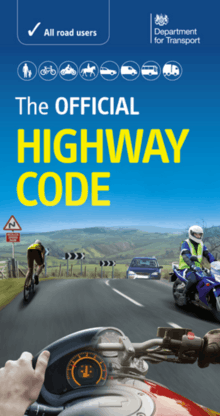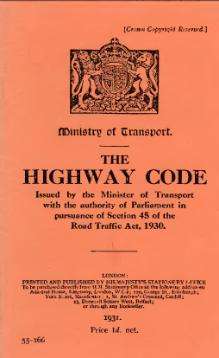The Highway Code

The Highway Code is a set of information, advice, guides and mandatory rules for all road users in the United Kingdom. Its objective is to promote road safety. The Highway Code applies to drivers of animals, pedestrians, cyclists, motorcyclists and drivers. The 2004 version, for example, contained 307 numbered rules and 9 annexes. The Highway Code gives information on road signs, road markings, vehicle markings, and road safety. The annexes include information on vehicle maintenance, licence requirements, documentation, penalties, and vehicle security.
Any failure to comply with the Code is not an offence in itself, but can be taken into account by a court. The mandatory rules reflect the Statute Law, which may (and usually does) provide a separate penalty.
The highway code was first published in 1931 as a booklet and has been regularly updated to reflect current practices.[1] It is prepared by the Department for Transport and the Driver and Vehicle Standards Agency, and is published by The Stationery Office in electronic form and as a printed book. Most copies are bought by learner drivers preparing for their driving test. In 2004, for example, over one million copies of the Highway Code were sold.[2]
The Great Britain version, available in English and Welsh, applies to England, Scotland and Wales, but regional specific signs such as driver location signs in England or bilingual signs in Scotland and Wales are not covered. The Northern Ireland version, available in English and Irish, applies to Northern Ireland.
History

(Djvu file: click on the image to browse though the pages)
Costing one penny, the first edition of the Highway Code was published on 14 April 1931. It contained just 18 pages of advice, including the arm signals to be given by drivers and police officers controlling traffic. The second edition, considerably expanded, appeared in 1934, and now illustrated road signs for the first time. During its preparation the Ministry of Transport consulted with the Pedestrians Association.[3] Further major revisions followed after the Second World War so that, for example, references to trams were still included in the 1954 version but disappeared after that (tramway rules returned to the Code in 1994, after the first modern tram systems in Britain had opened). Motorway driving was included in the fifth edition. The sixth edition, in 1968, used photographs as well as drawings for the first time, and also updated the illustrations of road signs to take the new 'continental' designs into account. The 70-page 1978 edition introduced the Green Cross Code for pedestrians and orange badges for less able drivers. The format was changed to a 'taller' size in the 1990s, and the Code caught up with developments in social media in 2011, when it joined Twitter and Facebook. A Highway Code app followed in 2012.
Legal aspects
Certain rules in the Highway Code are legal requirements and are identified by the words ‘must’ or ‘must not’. In these cases, the rules also include references to the corresponding legislation. Offenders may be cautioned, given licence penalty points, fined, banned from driving, or imprisoned, depending on the severity of the offence. Although failure to comply with the other rules would not, in itself, cause a person to be prosecuted, the Highway Code may be used in court under the Road Traffic Act to establish liability. These include advisory rules with wording ‘should’ and ‘should not’ or ‘do’ and ‘do not’. In general, only the latest official printed version of the Highway Code should be used but in legal proceedings, whether civil or criminal, the version current at the time of the incident would apply.
The Road Traffic Act 1988 states:
A failure on the part of a person to observe a provision of The Highway Code shall not of itself render that person liable to criminal proceedings of any kind but any such failure may in any proceedings (whether civil or criminal, and including proceedings for an offence under the Traffic Acts, the [1981 c. 14.] Public Passenger Vehicles Act 1981 or sections 18 to 23 of the [1985 c. 67.] Transport Act 1985) be relied upon by any party to the proceedings as tending to establish or negative any liability which is in question in those proceedings.[4]
Access
The Highway Code is available in the following forms:
- book English or Welsh; and for Northern Ireland
- eBook
- iPhone, iPod Touch and iPad app[5]
- Audiobook
- PDF files, including Russian and Polish translations
- CD-ROM, also mirrored online
- DVD, with British sign language
The Highway code can also be accessed at the following locations:
See also
- Driver's manual, the United States equivalent of the Highway Code
- Road Users' Code, the Hong Kong equivalent of The Highway Code
- Malta's The Highway Code, the Maltese equivalent of the Highway Code
- Ireland's Rules of the Road, the Irish equivalent of the Highway Code
- Green Cross Code
- Road surface marking
- Road marking machine
- Traffic Signs Regulations and General Directions
- Vienna Convention on Road Traffic
- Vienna Convention on Road Signs and Signals
References
- ↑ "Introduction". Highway Code. HMSO. Retrieved 2007-11-18.
- ↑ "History of the Highway Code". Driving Standards Agency. 2012. Retrieved 14 May 2012.
- ↑ "The history of the Pedestrians Association". Living Streets. Archived from the original on 2010-08-07. Retrieved 2010-02-27.
- ↑ "Road Traffic Act 1988 (c.52), s.38(7)". Office of Public Sector Information. Retrieved 3 August 2006.
- ↑ "Official Highway Code for iPhone, iPod Touch and iPad". Driving Standards Agency. 2012. Retrieved 14 May 2012.
Further reading
- Department for Transport, Driving Standards Agency (28 September 2007). The Official Highway Code 2007 Edition. The Stationery Office. ISBN 0-11-552814-8.
External links


- The Highway Code (in English)
- The Highway Code for Northern Ireland (in English)
- The Highway Code for Northern Ireland (in Irish)